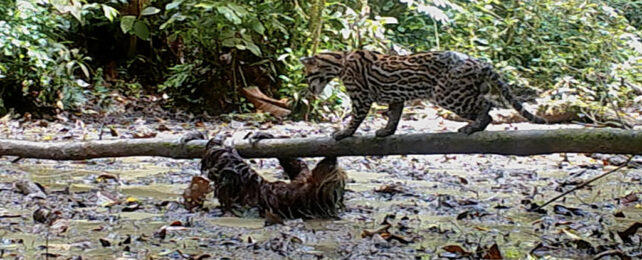
Traditionally known for being slow-moving tree-dwellers, it would be to easy to assume a sloth would come out second best with any predator while on the ground.
A camera trap out in the Amazonian wilderness provided a rare front-row seat at just such a brawl, and the footage is surprising, showing a sloth actually fighting off and escaping an ocelot interrupting its daytime snacking.
As researchers from the Universidad de los Andes in Colombia, the University of Texas, Austin in the US, and the Universidad San Francisco de Quito in Ecuador point out in an accompanying paper, the captured footage is pretty rare.

Firstly, predation attacks aren’t often caught on camera. Secondly, sloths usually visit mineral licks at night, when it’s safer. Thirdly, sloths hadn’t previously been considered as targets for ocelots – and it’s not clear how the ocelot might have been planning to do the capturing.
“Both two-toed sloths and ocelots are difficult animals to study,” says anthropologist Anthony Di Fiore, from the University of Texas at Austin. “They are quiet, elusive and hard to find and observe in the wild.”

The researchers can’t say for sure if the sloth managed to escape fully unscathed, because of the limits of the camera trap’s field of view. However, they returned to the scene two days after the videos were filmed, and found no evidence of sloth remains.
Very few sloth visits to mineral licks have been recorded – just a single one in almost 4,000 nights in a 2011 study – and these clips show the dangers of venturing down from the trees where the animals are further away from potential predators. That’s especially true when visiting a place that’s a popular feeding ground for numerous species.

The videos are useful in telling us more about both animals, the researchers say: both the habits of sloths, and the animals that ocelots prey on. Ocelots normally eat smaller creatures, like snakes, turtles, and frogs, but have been known to attack larger prey too.
It’s also a reminder that animals that tend to move slowly and have slow metabolisms can still be a match for more nimble creatures out in the wild. We’ll have to wait and see whether any more dramatic ocelot-on-sloth events get filmed at this spot.

“This video provides a snapshot of interesting aspects of the natural history of both species, showing a possible prey-predator relationship which has seldom been considered and showing diurnal activity for the predominantly nocturnal two-toed sloth,” says Di Fiore.